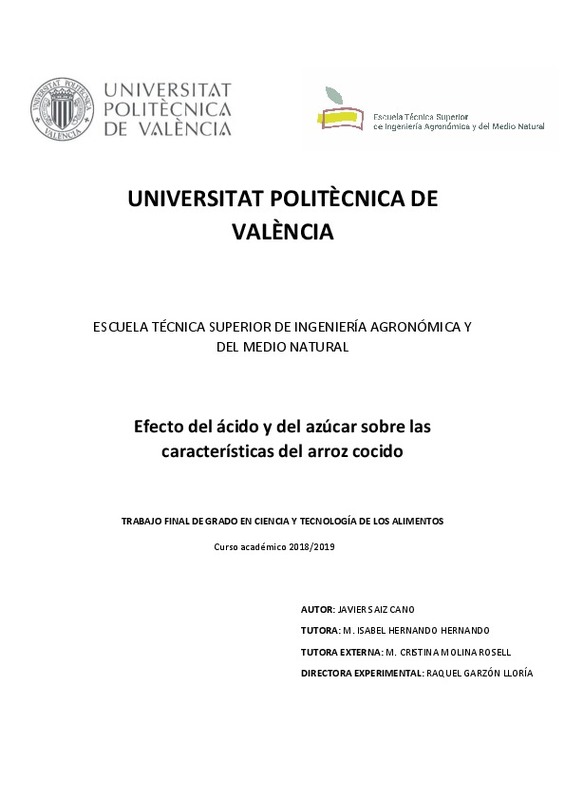|
Resumen:
|
[ES] La aparición de nuevas tendencias alimentarias de origen extranjero en España es un
hecho que se ha visto impulsado en los últimos años gracias al auge de la comida preparada y a
domicilio, una de las tendencias más ...[+]
[ES] La aparición de nuevas tendencias alimentarias de origen extranjero en España es un
hecho que se ha visto impulsado en los últimos años gracias al auge de la comida preparada y a
domicilio, una de las tendencias más representativas en este sentido es el consumo de Sushi. Un
tipo de comida de origen japonés caracterizado por estar constituido principalmente de arroz
avinagrado y pescado crudo. Debido a esta creciente popularidad la industria ha mostrado su
interés llevando su producción a una escala mayor e intentando obtener productos de calidad
homogénea y estables en el tiempo. Es por ello por lo que, el objetivo del presente trabajo fue
estudiar el impacto en el perfil de textura, de los distintos ingredientes del preparado de sushi
(vinagre, azúcar y sal) que se adiciona al arroz cocido para el posterior formado de sushi en
forma de nigiris. En primer lugar, se analizaron los distintos vinagres que hay en el mercado con
el fin de conocer la cantidad de ácido acético que puedan tener, así como su contenido de sal y
de azúcar. Posteriormente se optimizó y caracterizó la cocción del arroz atendiendo al tiempo
óptimo de cocción, color, absorción de agua, y humedad. Finalmente se analizó el efecto en el
perfil de textura de distintas relaciones de cantidad de arroz cocido: preparado de sushi (1:0;
1:0,1; 1:0,2; 1:0,3 y 1:0,5 (p/p)). Además del efecto en la textura del arroz y del nigiri de la adición
de ácido acético (0; 1; 3; 5; 6 y 7%), sal (0; 2,5; 5; 7,5 y 10%) y azúcar (0; 10; 20; 30; 40 y 50%)
individualmente. La cantidad de preparado de sushi añadido al arroz cocido afectó tanto a la
dureza como a la capacidad de recuperación de los nigiris. El aumento de la proporción originó
nigiris más blandos hasta la relación de 1:0,2 (p/p) donde ya no se encontraron cambios
significativos. La adición de sal produjo un efecto estadísticamente significativo en la dureza y la
adhesividad del arroz y del nigiri. El efecto del azúcar fue principalmente sobre la capacidad de
recuperación de las dos formas de estudio. Sin embargo, el efecto del ácido acético afectó de
diferente forma al arroz cocido, en el que tuvo un efecto sobre la dureza, que al nigiri donde
influyó sobre la adhesividad. El ácido acético demostró mejorar la estabilidad de los parámetros
texturales a corto plazo para el arroz y para los nigiris. Los resultados obtenidos mostraron la
importancia tanto de la cantidad de preparado a utilizar, como de cada uno de los componentes
y sus concentraciones en el perfil de textura. Sin embargo, se requieren estudios adicionales que
permitan profundizar en el efecto originado en el arroz cocido.
[-]
[EN] The appearance of new food trends of foreign origin in Spain is a fact that has been
increasing for the last years due to the rise in the market of ready-to-eat and home served food,
one of the most representative ...[+]
[EN] The appearance of new food trends of foreign origin in Spain is a fact that has been
increasing for the last years due to the rise in the market of ready-to-eat and home served food,
one of the most representative trends in this sense is the consumption of Sushi, a type of food
from Japanese origin which is constituted mainly of vinegary dressed rice and crude fish. Due to
this rising popularity the food industry has manifested its interest in the sushi large-scale
production and quality homogeneous products that remain stable through time. It is therefore
the objective of this work to study the impact in the rice texture profile of the different
ingredients of the sushi rice dressing (vinegar, sugar and salt), which is applied after cooking the
rice to produce sushi in the form of nigiris. Firstly, different commercial vinegars were analyzed
in order to know the quantity of acetic acid, salt, and sugar in their composition. Secondly,
cooking of rice was optimized and characterized regarding optimal cooking time, color, water
absorption and humidity. Lastly, the impact in the texture profile of different relations for
quantity of cooked rice:sushi rice dressing (1:0; 1:0,1; 1:0,2; 1:0,3 y 1:0,5 (w/w) was analyzed.
The effect in the rice and nigiri texture was analyzed for acetic acid (0; 1; 3; 5; 6 y 7%) salt (0;
2,5; 5; 7,5 y 10%) and sugar (0; 10; 20; 30; 40 y 50%) separately. The quantity of sushi dressing
applied to the rice affected the hardness and resilience of nigiris. The increase in quantity
produced softer nigiris until 1:0,2 (w/w) relation, no significative differences were observed in
greater amounts of dressing. The addition of salt produced a statistical significative effect on
hardness and adhesiveness for the rice alone and the nigiris. The effect of sugar was mainly on
the resilience in both the rice and nigiris. However, acetic acid affected the hardness of cooked
rice and the adhesiveness of the nigiris. Acetic acid proved to improve short term textural
stability for both rice and nigiris. Results obtained showed the importance of both the quantity
of dressing applied and the importance of each ingredient and their concentrations in the
texture profile of the product. Nevertheless, additional studies are required for better
understanding of the effects in the cooked rice.
[-]
|







